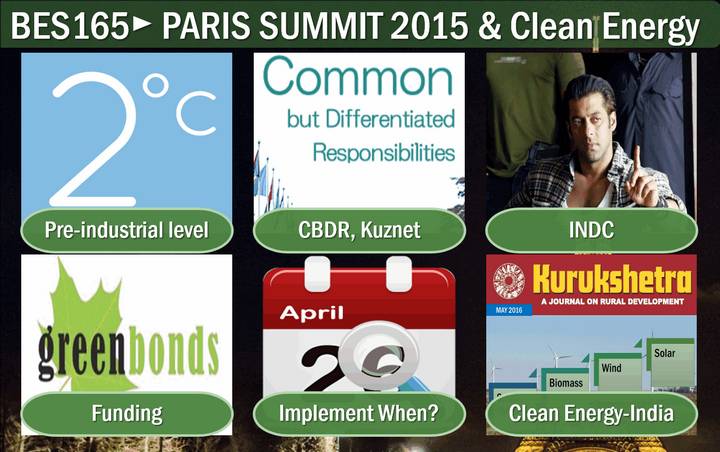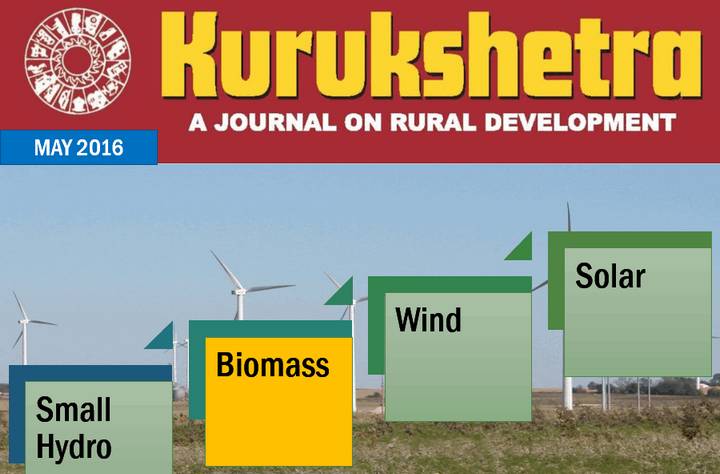- BES165/P1: Paris Summit- Outcomes, INDC, Finance, Ratification, Kuznet Curve
- BES165/P2: Clean Energy: Biomass, RDF, Biofuel- classification, extraction Methods, GS3 Achievement of Indians
- BES165/P3: Nuclear Energy, Reactor Types, Kakrapar Incident, NSG-MTCR & other export control groups,
- BES165/P4: Thermal Energy, UJALA, UDAY bonds, Hydrocarbon Policy HELP-2016, DMF, PMKKKY
BES165/P1: Paris Summit- Outcomes, INDC, Finance, Ratification, Kuznet Curve
- Events leading to Paris Summit of UNFCCC
- What is 2 degree above pre-industrial level? Why is 2015 called the warmest year?
- Environmental Kuznet Curve: inverted U-shape curve, CBDR,
- CO2 emission: India’s source wise ranking, world ranking, common but differentiated responsibilities- what decisions were taken in this regard during UNFCCC COP-21 Paris summit?
- Intended Nationally Determined Contribution (INDC): Paris decisions on their submission deadline and non-punitive biennial review mechanism, and its criticism.
- India’s INDC: 1) emission intensity of GDP 2) additional forest cover for carbon sink 3) target of 175 gigawatts of renewable electricity – criticism against India’s INDC
- International climate finance mechanisms, clean technology fund, problems related to double counting and bogus promises by first world countries.
- Green bonds: finance mechanism and bottlenecks observed by the economic survey.
- Coal cess, National adaptation fund for climate change.
- Understanding the difference between signing and ratification. How many parties need to ratify before Paris agreement is implemented? CAPF-2016 question from this.
Youtube Link: https://youtu.be/rv6Q6pVMjUM
BES165/P2: Clean Energy: Biomass, RDF, Biofuel- classification, extraction Methods, GS3 Achievement of Indians
- Gist of Kurukshetra magazine May 2016 issue on renewable energy sources
- Potential and limitations of solar, wind, biomass, small hydro energy sources in India.
- Difference between biogas, bio-methane and CNG
- Meaning, Evolution and classification of biofuels – first, second and third generation
- Biochemical and thermochemical methods to extract biofuel from biomass. Jetropha and Transesterification
- Mains GS2: Role of NGO, Barefoot college and solar technician women
- Mains GS2: Policy design issues: Unnat Chulha mission/ biomass-cooking stoves
- Mains GS3: Achievements of Indians in science & technology; indigenization of technology and developing new technology- with special reference to solar, Biomass and small hydro energy. Prince-40 cooker, IIT-Delhi Bio-CNG kit, Modified Small hydro-plant
Youtube Link: https://youtu.be/8egcrg7xuX0
BES165/P3: Nuclear Energy, Reactor Types, Kakrapar Incident, NSG-MTCR & other export control groups,
- Types of nuclear material: fusion vs fissile material
- Types of nuclear reactors: fast breeder reactor, boiling water reactor, pressurised water reactor (PWR), Pressurized heavy water reactor (PHWR), advanced heavy water reactor (AHWR)
- Major nuclear projects in India- which technology to be used, which foreign countries and companies have helped them – memorisation technique.
- 7 point nuclear accident classification of IAEA
- Three stages of India’s nuclear programme. What happened in Kakrapar?
- 4 export control groups: Nuke Supplier Group ‘74 (48 members), Australia Group’85 (42 members), MTCR’ 87 (34 +India=35 members), Wassenaar’96 (41 members)
- Why couldn’t India get membership to NSG? What benefits will India reap by joining MTCR- Missile technology control regime?
Youtube Link: https://youtu.be/y9X57a7OWEk
BES165/P4: Thermal Energy, UJALA, UDAY bonds, Hydrocarbon Policy HELP-2016, DMF, PMKKKY
- Thermal electricity in India before and after independence.
- Taxation provisions on sale of electricity.
- Statutory organisations, joint ventures and public sector undertakings under the Power Ministry
- Electricity Act 2003, Open Access policy, Tariff measures, problem of Salience
- Deendayal Upadhyaya GramJyoti (DDUGJY) Budget’14
- Integrated Power Development Scheme (IPDS) Dec’14
- National LED Program, UJALA, DELP, SNLP- introducing LED bulbs in residential use and streetlights.
- Bulb theory: scientific principles behind tungsten bulb, CFL, LED, Gas discharge lamps.
- Ujwal DISCOM Assurance Yojana (Uday)- why do electricity companies are making losses? What are Uday bonds? How is cooperative federalism promoted through this scheme?
- Progressive electricity tariff and cross-subsidisation in residential electricity use- Why is survey recommending this?
- Conventional versus unconventional energy gases- shale gas, syngas and CBM, Farzad-B gas reserve
- Hydrocarbon Exploration & Licensing Policy (HELP)-2016: salient features, compare and contrast with previous NELP policy. What is meant by uniform single license, open acreage policy, graded royalty system, profit sharing vs. revenue sharing contracts.
- Metalic and non-metalic Mineral ranking of various states as per IYB-2016 ch. 16
- District Mineral Foundation (DMF), Pradhan Mantri Khanij Kshetra Kalyan Yojna (PMKKKY)
- 8 core industries under IIP, survey observation on their recovery.
Youtube Link: https://youtu.be/1wqWz-NSCEw
Powerpoints of all videos, are available here: mediafire.com/folder/xemd2vgz5a5d5/1_Powerpoints





![[Summary] Budget & Economic Survey 2018 Gist for the UPSC IAS/IPS Interviews](https://mrunal.org/wp-content/uploads/2018/02/c-bes18-basanti-500x383.jpg)
![[BES171] Banking-Classification: Wholesale Banks, Cooperative Banks, DFI AIFI, MUDRA Bank, Islamic Bank, NBFCs & Indigenous Moneylenders](https://mrunal.org/wp-content/uploads/2017/05/c-bes171-evo-2-500x383.gif)
![[BES171] Banking-Classification: RBI Structure Functions, Nationalization, Scheduled Banks, Merger of SBI Associate Banks & BMB, Private Banks, SFB & Payment Banks](https://mrunal.org/wp-content/uploads/2017/02/c-bes171-cover-500x383.gif)
Thanks a lot for your invaluable afford I have seen ever best economic teacher
thank you sir….very helpful as always
thanks mrunal sir
Thanks Sir, you are the best… I really appreciate your work..
thank you sir
a salute to you sir.
mrunal sir no words … right on time… ppts are great .. we are forever indebted sir \,,/
Could u pls me the ppts or link where I could download the new ppts. Pls.
Thank You. I am in urgent need.
Thank you Mrunal sir:)
This is something miraculous. Hats off sir. Have never seen a teacher better than you. Awesome videos. Thank you so so much Sir.
Highly indebted !
Thanks will be an understatement. Your contribution at the last minute is priceless..
Thanks a lot mrunal sir for ur lecture on Paris climate.it’s most valuable for us!
sir i m not able to access the power point lectures
Sir,i would like to know net proceed of cess and surcharge goes in which account?
As Cess is levied for specific purpose, it is accrued into Public Account of India.
In case for Surcharge, it is accrued into Consolidated Fund Of India as it is not levied for any specific purpose.
sir, In WTO what is the meaning of Consensus. ? Is it approval of all members or 80%?
Government borrowing from public does affect the money supply in the market?
Sir please provide me all new happenings that affect India and World.
Hii I give test series I get less marks will I attempt the paper or not plz guide me
Paris summit and uday purpose asked in upsc csat 2016 paper.very useful articles from you Mrunal sir….thank you very much sir..and please provide detailed analysis of csat 2016 paper. If any help requires, I am ready to do so. Thanks sir
sir one request pl …………………. start ur video lecture in english also it is humble request from all non hindi upsc aspirants
Bro the institution in which he teaches asks him to give lecture in Hindi so even if you request him it wont be possible for him to teach in English
may anyone help me about how to start with mrunal topics…i dpnt understand how to read it..please help